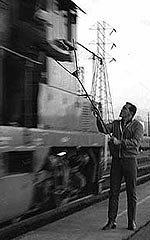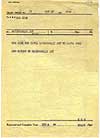In simplest terms, train orders were messages sent from a central dispatcher via telegraph (later: telephone) to a lineside station operator, who copied them them onto paper and deliver them to train and engine (T&E) crews. These messages controlled and protected train movements, and were regarded as immutable command orders, just as a general gave to his troops. Crews had to follow them to the letter, for otherwise, they and their trains might not make it to the other end of the line in one piece. This whole system was known as movement by train orders. While the following has a Southern Pacific flavor, it nevertheless discusses universal principles that apply to most railroads, past and present.

Samuel Morse's telegraph first came to the railroads in 1851, and embryonic train order (TO) systems soon followed. TO's represented a revolutionary advancement in the organized movement of trains. Formerly, once a train left its initial station, it progressed faster than any communication intended to modify its movement, save carrier pigeons. This was fine...if things went according to the original plan, which often was not the case. If one train fell behind its schedule, or broke down, things fell apart in a hurry.
Once the telegraph was installed at intermediate stations, the dispatcher gained the power to 'call an audible', so to speak. Train movements could be modified, or stopped, at these intermediate points. Not only did this produce smoother running railroads, but safer ones as well. Fewer went into the ditch because the tracks had washed out.
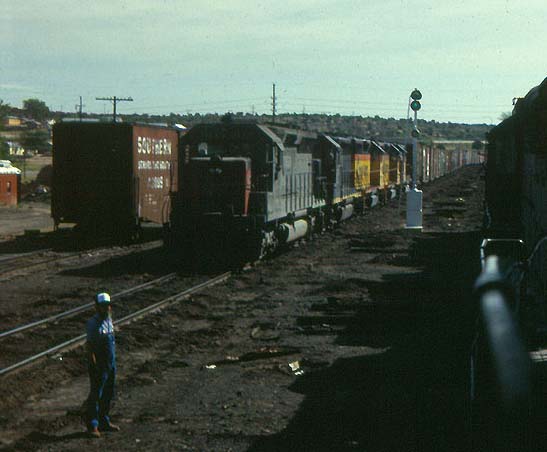
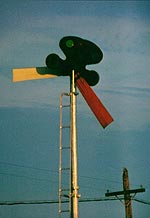
(above) Southern Pacific semaphore-style train order signal, Gilroy CA, 1973. It displays a "clear board" (proceed) for an approaching train . Later version TO signals dispensed with the boards (semaphore arms), as seen (left) at Santa Rosa, NM in 1984.
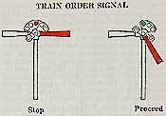
Train orders, evolved into an incredibly complicated method of dispatching trains - so complicated that T&E crews often argued about the orders' exact directions. Further, it seemed (to most of us, anyway) that there always remained grey areas where you just 'winged-it'. It could take years for the average operating employee to gain a full understanding of TO's, and some never did. Luckily, crews were large (4-5 people), so somebody was bound to correctly figure out things.
Since train order dispatching has largely been confined to the proverbial dust heap - and since a detailed explanation of its intricacies can get pretty darn boring - we are instead going to give you an overview, with examples and tidbits of Southern Pacific practice that you should find interesting.
Of course, if you are a glutton for punishment, just pick up an old SP rule book and study the train order rules themselves. We guarantee that these rules, sans our witty commentary, will put you to sleep faster than a warm afternoon in the head brakeman's seat. Without Wx4's loving guidance, you really won't learn much, anyway, except that TO rules are plentiful and exasperating.
In learning the basics of TO's, what you are really learning is the universal fundamentals of how to move trains safely and efficiently. The principles guiding the movement of trains are the same no matter the dispatching arrangement, ancient or modern. There's value in this, for you will comprehend how railroads operate and appreciate just how much things have changed in the last quarter-century. Further, you'll probably understand why we professional rails are so happy to be rid of TO's.
Modern methods of dispatching (see the Direct Traffic Control page for one example) are relatively simple because the dispatcher no longer has to rely upon operating crews to create the tactics to carry out his strategy. For example, these days a dispatcher may directly radio a crew some instructions that effectively state, take the siding at Earl and call me after one train goes by. The crew doesn't need to know the identity nor direction of the other train. This is all done in real time, so these directions may come at the last moment.
Under TO's, the real-time element was largely nonexistent, so the dispatcher had to rely on the train crew to use their own judgement regarding the best place to meet. So for the same meet as above at Earl, they may interpret a pile of train orders to read:
Extra 7770 West has to wait at Earl until 6 PM, so meet him there, unless you can't make it in time, in which case meet him at Al, because the siding at Bob is blocked by derailed banana cars. BUT, if you can make it to Herb by 4:45pm, meet the 7770 there, unless clouds obscure the sun or your locomotive is painted blue. At any rate, you'd better make it to the train order station at Al by 3 PM. If you don't, I'm going to have the train order operator throw the board red, and you are going to rot at a siding without an open cafe, because I'm going home and turning over the mess to the afternoon dispatcher.
A good crew can read between the lines.
As we've said, the train order system is built upon some universal fundamentals common to all dispatching setups, the most important being authority and protection. Likewise, we've discussed how, under TO's, much of the decision-making - particularly in the case of where trains are to meet - is done by the conductor and engineer, so they must know about their train's relative priority with others. The rules governing the Superiority of Trains figure highly here. Lastly, communication of train orders must be highly structured to insure that they are mistake-free and delivered to the trains in proper order.
Reader note: Although U.S. railroads no longer dispatch by train orders, the following is written in the present tense for simplicity's sake.
Protection comes in many forms, from several sources, and is employed according to the particular situation. Trains need to be protected from other trains and a myriad of hazards such as bad track and construction on the right-of-way. This protection can come from such things as lineside signals, crossing gates, and the actions of the crews themselves. In the latter respect, T&E employees are expected to keep current on host of paperwork (timetables, special instructions, notices, rule books, more), so that they may properly protect their trains and themselves.
Train orders can perform many of these roles. In fact, most forms of train orders are considered to be protection. For example, a TO arranging a meet between trains is protecting these trains from a possible collision. Providing protection is the complicated part of train orders.
Authority is simply the right to occupy the main track, and in terms of authority, there are only two types of trains. Nope, you guessed wrong - not passenger and freight. A passenger or freight train operating on a regular schedule is called a regular train. Regular trains receive their authority from a schedule published in the employee timetable. Extra trains - usually freight, but sometimes passenger - are not listed in the timetable, so they must (in most cases) derive their authority from a train order. Extra trains are identified by their engine number.
A train order operator may hand an extra train conductor a pile of three dozen TO's - enough to make "The Big O's (conductor's) head spin for twenty minutes - but only the very last one (ALWAYS the last one) gives his train its authority (a "running order"). It often simply will read something like ,"Engine 6432, run extra from Tucumcari to Roy." Authority is always subservient to protection, and the dispatcher may not send a running a running order to the delivering operator before all of the protective orders are in place. Ultimately, all that the X6432's authority means is that the dispatcher will allow the train to proceed as far as Roy if all of the protection considerations don't cause the crew to run out of Hours of Service time in mid-route. Sometimes, things don't work out.
Time Applies
BUT, attention to time is not enough. You must also know the exact location where the other train will be waiting for you at a given time - the point where time applies. When there is a siding, the point is at the spot where an inferior train (see Superiority of Trains, below) must be clear of the main track. In other words, the inferior train's caboose must be clear of the main track before the superior train is due to leave. Now, what Rule 5 says is that if the inferior train can't clear into this particular siding in time, it must wait at the previous one (a.k.a. the next siding AHEAD of the superior train).

- Main line meet - This happens when two trains stop for each other on the main line between sidings. Obviously, one train must back up to the nearest siding. The cause can be either crew or dispatcher oversight.
- One-legged meet - If the dispatcher arranges a fixed meeting point, but mistakenly only notifies one train, the result can be the same as a main line meet.
- Cornfield meet - This worst possible scenario - two trains crashing into each other head-on - usually is caused by crew, rather than dispatcher, oversight.
Note that your garden variety block signal is designed to protect from following trains, not from opposing trains, so overlooking a meet is a dangerous thing, even in signalled territory.
Trains
A train order (known as a "right over order") that reads Extra 4449 has right over all trains from San Jose to Salinas means that this train owns the railroad. Even scheduled trains like the Coast Daylight must take a siding to let the 4449 go by.
In the absence of any right-over orders, scheduled trains take precedence. As we know, scheduled trains receive their authority from the employee timetable. There, they are listed by class, with first class trains having priority over second class trains, which in turn have priority over third class trains, and so forth. Railroads often run regular trains in "sections", meaning that a second train runs under the timetable authority of the first train, and waiting trains must also wait for the second (third, fourth, fifth...) section . The second section of a passenger train, for instance, could be a freight train. The third section might be a solitary engine. As the rule says, trains of the same class are superior by direction - on most of the SP, timetables listed westbound trains as superior.
How extra trains superiority was determined is perhaps the most misunderstood aspect of SP train order operations. The general consensus amongst train and engine crews seemed to be that S-71 BY IMPLICATION conferred superiority by timetable direction, even though the rule specifically states that it applies to regular trains. I know a certain ex SP 40+ year engineer who retired under this misconception.
The confusion arose primarily because Rule #S-71 appears in the section entitled "Superiority of Trains", while for most of the Twentieth Century through several permutations of the Rule Book, Rule #S-88 (wrongly) five pages later, buried in "Movement of Trains". Early in the century, Rule 81(which in modified form later became S-71) plainly stated that the timetable determined determined superiority of "All trains", but wise rules department souls apparently thought that this was too straightforward, and that some obfuscation was in order.
Thus, Rule #S-88 elaborates on #S-71 by mandating that at Rule S-A meeting points, the extra train of inferior timetable direction [of regular trains] will take the siding unless otherwise instructed. An S-A meeting point takes place on single track ("S") is generally called a "flat meet" - see next page.
That this confusing arrangement was never remedied speaks enormously of the way SP functioned as an organization.
Trains
Head End: To serve this purpose, railroads use lights, flags and numbers on the front ("head end" of trains. Class lights and flags (see diagram, below) come in two colors, green and white. Green flags/class lights denote a regular train that has a following section. The last section, as well as a regular train with no following sections, displays no flags and extinguishes its class lights. White flags/class lights identify a train as an extra.
In the past, Southern Pacific and a few other railroads went even further. Locomotives carried train indicators (see below) to allow lineside identification of trains without having to know the engine number. This way the dispatcher would not have to issue train orders stating that "NO 101 HAS ENG 6034" and so forth.,
How these appliances are displayed gets pretty involved - SP's 1943 rule book contains seven pages of permutations.
Rear End: The rear of a train needed to be designated, as well. One reason by example: Say, a train lacks the power to make it up a hill, and the crew is forced to uncouple ("cut-off") the rear portion on the main track to give the engine a manageable number of cars (this is known as "doubling the hill"). Since a caboose is NOT an indication of the end of a train (if a caboose breaks down, no way is a train going to sit until the "cab" is repaired), the crew of a downhill train needs to I.D. the rear of the uphill one. Otherwise, Mr. Downhill Train, meet the rear portion of Mr. Uphill Train...
So, the end of a train must display red "marker" flags or lights (see below) at the rear piece of equipment on the train (caboose, passenger car, boxcar, engine, etc.). These red signals designate the end of the train. Today, in these cabooseless times, this function is performed by a box - a Flashing Rear End Device, or FRED - that displays a flashing red light at night, and uses red reflective tape by day as a red flag. Passenger trains still use conventional marker lights, usually permanently mounted ones that resemble tail lights. In olden times, marker lights also contained green lenses. When a train was stopped clear in the clear in a siding, and the switch re-lined for main track, the conductor would rotate the markers to show green lights to the side and rear. This was very helpful in preventing engineer heart attacks in unsignalled ("dark") territory, where there were no block signals to tell them what was going on.
SP did away with train indicator boards - except on the San Francisco Peninsula, where they remain to this day on Caltrain passenger trains - in 1967. Note that regular non-Peninsula SP trains had to be identified by "road" engine (usually the lead unit) in train orders after this date. Class lights continued in use on SP until 1983.
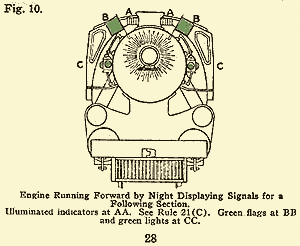
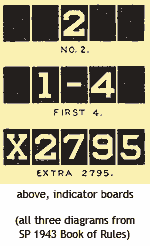

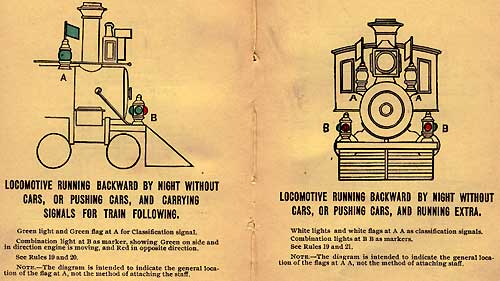
We're guessing that there must have been at least an unofficial industry standard here, since W&LE's 1905 signals were very close to SP's 1943 version. Both used 20 permutations of signals, counting both head and rear end.
Accordingly, the communication of TO's has to be handled with precision. Before a dispatcher comepletes an order by dictating the current time and his initials, the TO operator(s) must repeat it back to the dispatcher, who monitors the repeat for errors. On Southern Pacific, in certain special situations involving the restriction of a train's movement, the dispatcher did not complete an order until the receiving train was stopped, and the crew knew that they would receive this order. Some railroads go even further, requiring the conductor and/or the engineer to personally sign what is known as a Form 31 order (see Part 2) before the dispatcher can complete the order with the current time and his initials.
And then there is the problem of delivery to the "C&E" (conductor and engineer). Rule 208 (above), addresses one concern: that the crew of a train that is to take a siding, for example, receive the order before, or simultaneously with, the crew that will hold the main track. Note that this is only the first part of a rule and explanation that runs half a page in the operating (T&E) rule book, and a full page in SP's Instructions to Train Dispatchers and Operators. Further note that the latter, which was strictly devoted to train order rules and procedures, contained 63 pages.
Physical delivery is sometimes a major issue. Getting orders from the dispatcher to the train can be just as complicated as writing the darn things. The most dependable delivery method is to require the engineer to stop the train, so that he and the conductor can dismount and sign for the orders, as in the case of a Form 31.
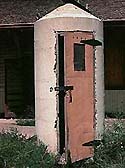
Typical concrete SP company phone booth, Santa Rosa, NM, 1983. For more, see How to Phone the Dispatcher.
The other aspect of deliver is how to get orders to a train stalled-out somewhere between train-order stations. If the crew is lucky, the train is at a siding which has a telephone booth (see photo, left) with a working line to the dispatcher. In later years, the radio largely eliminated the lineside phone as a backup, but the SP continued to use them on the Carrizozo Subdivision until DTC came along in 1984. The primary method of delivery was, however, to send them via another train. This could take a long time, especially if train order offices are 85 miles apart, like Carrizozo and Vaughn, New Mexico.
It should now be quite plain to you that the whole logistical process, dealing with both the required precision and the physical delivery, could eat up considerable time - scads of time. The lag between composition and execution is what killed the TO system.
